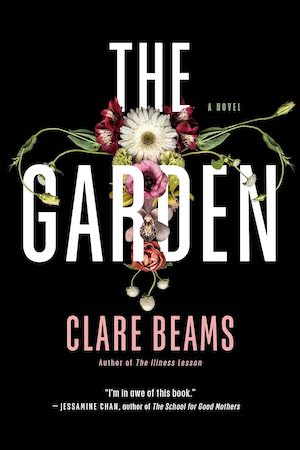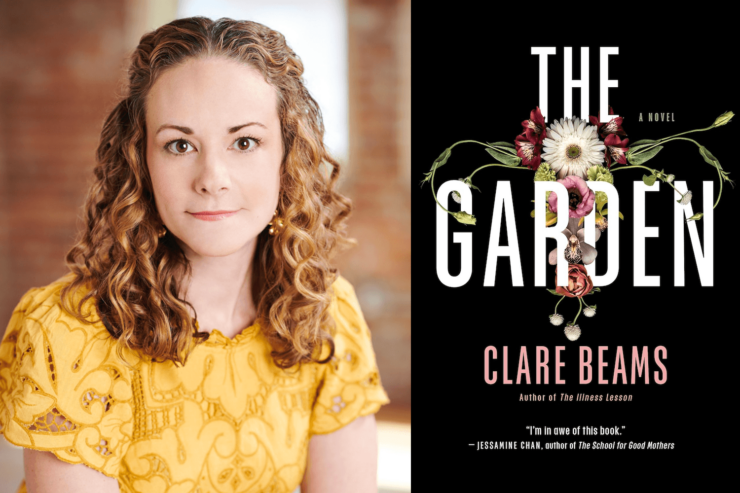In the following interview, Rita Chang-Eppig, author of Deep as the Sky, Red as the Sea, speaks with Clare Beams on the real stories that inspired her gothic horror novel, The Garden.
Rita Chang-Eppig: Thanks so much for chatting with me today. I loved The Garden—it was gothic and strange and just altogether hypnotic. The novel follows a pregnant character, Irene, and her ordeals inside a “hospital” that specializes in patients who have had multiple miscarriages. As I understand it, this hospital is loosely based off a real medical clinic that existed back in the day. Say a little bit about how you came across the information about this clinic and how that spawned, pun not intended, this particular novel.
Clare Beams: It wasn’t so much a real clinic as a real treatment, so the idea of this secretive house-hospital was really my invention. The drug itself is a real drug called diethylstilbestrol that was prescribed for decades in this country, and it was a husband and wife medical researcher team that pioneered the use of this drug in cases of repeated miscarriage as a preventative treatment. There were all kinds of flaws with the original study that are easier to see looking back, and there were a lot of early warning signs that this might be actually quite harmful. The idea was that if you gave women a really high dose of an artificial estrogen, you might even out some of the hormone swings that can occur around the time of miscarriage. That was what originally caught me when I came across the reference to this drug. This idea of “evening women out,” I think, is often a harbinger of frightening things to come. And the idea of this woman researcher who would have had to fight to be where she was being involved in this tragic medical story also caught me. I came across the reference to this drug when I was researching alternate titles for The Illness Lesson. I was scouring strange medical corners of the internet, trying to see if there was something that would be inspiring for a title. When I came across the story of DES, I thought, this is not going to work for this novel, but maybe there’s something there that I might explore for a future thing.
Rita: On one hand, I’m a little bit sad to learn there wasn’t this creepy house where medical experiments were taking place. On the other, that makes me admire the book more because I think that the decision to situate it within this mansion adds so much more creepiness.
Clare: What I wanted to do, although I didn’t know this at the beginning, was to write a book about pregnancy as a haunted house. And so I needed a haunted house to make that work.
Buy the Book


The Garden
Rita: Well, let’s talk a little about that. Pregnancy is depicted in all of its complexities here in the book. In our society, people like to talk about pregnancy as this serene, natural experience. Even the language that we use to talk about it has an exaltational quality to it, like, “Oh, you’re glowing!” But everyone I know who’s ever gone through pregnancy and childbirth will tell you there are some parts that are terrifying. It’s painful, it’s clinical, and sometimes it’s just downright grody. What kinds of things were you trying to communicate regarding this idea of pregnancy as a haunted house?
Clare: I love how you’re getting into that because what I wanted to explore was the tension between our theoretical idea of pregnancy and the experience of pregnancy. My experience with being pregnant was there’s so much about it that’s truly fascinating and amazing. But it was such an anxious state for me, and so unlike previous ways I had felt in my body. I am a person who tends to live from the neck up a lot of the time, and this was such an insistently embodied time in my life, and such a time of understanding that I really wanted something that I had no control over. In each of my pregnancies, there was a little thing they found that was not normal. I am an anxious person who, when I’m anxious, tries to go learn more about whatever it is that I’m anxious about in order to feel better. And this was the first time that that strategy fully failed me, because the more I learned, the more afraid I became. There’s just so much that we don’t know about pregnancy. And some of that not knowing is tied up with what you were talking about before, this idea of the pregnant woman as this exalted, untouchable, and not-to-be-touched sort of presence, like there’s something sacred happening and we’d better not get too close to it. When you’re actually experiencing it, it can be maddening because nothing is assured in any way. So I found that all to be a very haunting experience.
Rita: I’m so glad that you mentioned the word “control” because I feel like the book is saying something interesting about the human desire to control fundamentally uncontrollable things. The doctors are trying to control their patients’ bodies with science, but the science only goes so far. The patients end up trying to control their own bodies through the magic of the garden, but that magic only goes so far. Do you mind saying a little bit more about how you imagine each major character’s relationship to control?
Clare: I love this question because this was so important to me, this idea that the doctors are trying one method of control, and then the women are trying their own. It’s a similar impulse, really. The women have seen enough to know that what the doctors are doing doesn’t seem to be working, and so their strategy is to cast around some more and see if they can find something else that might offer hope. In my process, I’m usually looking for a situation that will let me explore some dynamic that I think is still relevant in our present, but in a more extreme way, extremes being our friend in fiction a lot of the time. This desire to know that things are okay or to do something to make sure things are okay—when I was pregnant, I followed every rule I could find. So I was looking for a situation that would let me explore that dynamic, but at a time and a place when in some ways even more would be riding on it, when women’s options were even more limited to this one role. For our main character, this is her only job to do for her husband, right? This is what he wants from her, and this is all he really wants from her.
Rita: Let’s talk about Shirley Jackson for a sec. The first thing I thought after I read the opening was that the Haunting of Hill House vibes were strong. There’s this sense of suffocation that comes with your description of the house. Did you go into this book wanting to evoke that comparison or did that come later in the process?
Clare: A little bit of both. For the novel to work, it’s important that these characters be effectively trapped. This place is so terrible that it needed to be clear why they would still be choosing to stay. They don’t have the freedom to leave because they believe that leaving would likely mean repeating the traumatic experience of miscarriage.
I had written a draft of this novel that was not as haunted, and that was in large part because the novel was divided in its perspective between Irene and Dr. Bishop, the woman doctor. The effect of going into Dr. Bishop’s mind was de-haunting because she knows more about the treatment than the patients do.
Every time we went into her mind, we were seeing behind the curtain of this house-hospital. Once I had realized that this is a ghost story, that was when I leaned into Shirley Jackson. I also went and read Edith Wharton’s ghost stories to remind myself of the ghost story as a form—how could I play with those beats when it’s both an external and an internal haunting? In Haunting of Hill House, it’s certainly both external and internal.
Rita: I love that it’s so often unclear if something is actually happening or if we’re dealing with an internal event. There’s an uneasy relationship between reality and fantasy. Sometimes it’s less scary to know that there is a monster going around, or at least it’s a very different kind of horror. What do you think is the value of uncertainty in fiction?
Clare: For me, what is frightening is uncertainty. Because as soon as you know the monster is there, then what you’re supposed to do becomes very clear. You might get away or you might not, but at least you know what the terms are.
I think so much of our lives takes place in a zone of “Is that what happened or is that what I thought happened, and what are the implications of either one in terms of how I move forward?” For me, the stories that require the lens of fiction are the stories with that kind of complexity, where the story changes depending on who’s telling it. That is what fiction can do that other art forms can’t, that kind of interiority. The stories that draw me are the ones where interiority doesn’t just reflect the external world but is actually changing the external world in some way.
Rita: Well, this novel definitely draws you in. I hope folks will pick up a copy of The Garden, out now.










